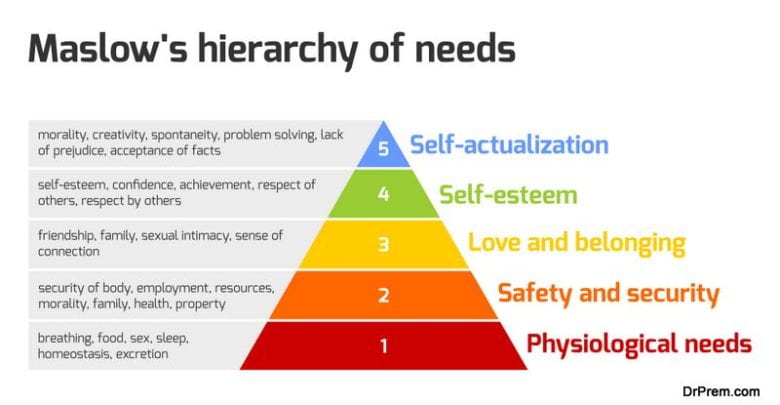Over 75 years ago, at only the age of 35 years old, Abraham Maslow wrote a paper called “A Theory of Human Motivation,” in which he created the foundation for what has become the widely-known and often referenced Maslow’s Hierarchy of Needs.
Briefly, for those unfamiliar with it, the model suggests there are four primary needs that all humans must have met before they can reach a state of being truly fulfilled, or self-actualized, as Maslow termed it.
The model is commonly taught in almost all introductory psychology courses and in many, if not most, other fields where humans are studied. It has been referenced over 100,000 times in peer-reviewed articles and mentioned in millions more talks and articles.
In 2011, there was a five year study done on 60,865 subjects from 123 nations, that confirmed these human needs are universal across the world. This study also confirmed what Maslow had suggested before his passing, that the levels don’t have to be progressed through in the exact order they are in the pyramid.
The reason Maslow’s model has become ubiquitous is that understanding human motivation is key to business, medical, political, and educational success. I think we generally agree that without our basic physiological needs being met (bottom row), we are going to have a hard time focusing on life, work or school. When we are hungry, thirsty, struggling to breath, unable to get enough sleep, or wonder where we will even sleep at night, we don’t perform at our best. In addition, when we don’t feel safe or secure (second row up), or we are worried about our health, or don’t have a steady source of income, we have a difficult time focusing on higher order thinking and acting. Imagine trying to study knowing there have been several serious crimes near where you live, or you can’t seem to recover from constant headaches, or knowing that you will be without a job in a few months.
Third, we are social beings in need of love and belonging (third row up) and it has been proven, in well designed and run experiments, that preventing people from having social interaction is harmful in a multitude of ways. It is difficult to focus on work or school knowing our family members are thousands of miles away and unable to help. This is especially true if our new college or job has resulted in moving to a city where we don’t know anyone and have no idea how to find friends. In recent years there has been a glut of studies suggesting we are in the midst of a “loneliness epidemic” and to compound the issue, most of these studies were published before the socially isolating COVID pandemic.
proven, in well designed and run experiments, that preventing people from having social interaction is harmful in a multitude of ways. It is difficult to focus on work or school knowing our family members are thousands of miles away and unable to help. This is especially true if our new college or job has resulted in moving to a city where we don’t know anyone and have no idea how to find friends. In recent years there has been a glut of studies suggesting we are in the midst of a “loneliness epidemic” and to compound the issue, most of these studies were published before the socially isolating COVID pandemic.
Lastly, how will we succeed in life (or college) if we lack self-respect and the respect of others (fourth row up)? Almost everyone worries about their physical looks, their clothes, and/or their ability to learn various life skills. In Maslow’s “Esteem” category, he also grouped the importance of others respecting who we are and what we do. It is hard enough going out each day feeling insecure about various aspects of ourselves, but when this is combined with low respect of others for us, it can be crippling to our daily functioning.
As someone who thinks regularly about college student success, it struck me that the major factors in student success line up well with Maslow’s Hierarchy of Needs. In one of my articles on an analogy for college student retention, I described “the Big Three” of student success as the three wheels of a tricycle. These included the finances to take care of basic needs, outside of the class engagement to provide a sense of belonging, and academic engagement to demonstrate an ability to succeed in classes.
major factors in student success line up well with Maslow’s Hierarchy of Needs. In one of my articles on an analogy for college student retention, I described “the Big Three” of student success as the three wheels of a tricycle. These included the finances to take care of basic needs, outside of the class engagement to provide a sense of belonging, and academic engagement to demonstrate an ability to succeed in classes.
If any one of the wheels of a tricycle fall off, the tricycle is unusable. Without money, students don’t have housing, food, books, classes, etc. Without co-curricular engagement, students don’t feel a sense of connection, they lack friendships, and they are only on campus a few hours a week for classes. Without academic engagement, which includes attending class, studying regularly, interacting with faculty, etc., students often struggle to earn the grades needed to persist.
In addition to “The Big Three” factors for student success, my student persistence analogy, which is rooted in the student success literature, argued that there are several pre-college factors essential to student success. These factors also align well with Maslow’s model. One of these factors was family support which syncs with Maslow’s love and belonging rung, and two other pre-college factors I proposed included academic preparation and self-management, which, without either of these, it could be argued, would make the esteem rung of Maslow’s model difficult to attain.
In short, as I studied the various rungs of Maslow’s Hierarchical Model, I discovered that my pyramid of needs for student success mirrored Maslow’s pyramid in many ways.
On first glance, the existence of five rows progressing in levels of cognitive complexity is evident in both pyramids. Extending the comparison reveals that without financial resources in college, physiological needs like food, shelter, clothing and college tuition will be difficult to meet. Up one rung, “Supportive & Safe Environment,” college students need to know that they are safe and secure, able to access health care, and find part-time employment, if needed.
“Sense of Belonging” in college includes friendships, family, faculty and staff support, and campus involvement, all resulting in a connection to the university. “Self Management” is term that sounds different than Maslow’s “Esteem,” but in part this is due to the cultural shift and research away from self-esteem to a focus on self-management and resilience as keys to success. A belief in ourselves is not enough to be successful – we must demonstrate our ability to manage or discipline our actions.
I should note that the peak of my pyramid is labelled “Purpose”, a key attribute in the student success literature and included in the second phase of my analogy for student success (moving from tricycle to bicycle). While purpose might seem a bit different than Maslow’s self-actualization, it should be noted that in one of his hierarchy’s revisions before he died, Maslow added a rung above self-actualization that he termed “transcendence,” which was based on a belief in something higher than oneself. This focus aligns even closer with “Purpose” in my suggested pyramid of student success.
In conclusion, I wrote this article to demonstrate the strong parallels between Maslow’s Hierarchy of Needs and the student success literature. In fact, I propose that a Hierarchy of Needs for Student Success could be of help to university educators. The prevailing variable used by almost all colleges is student grade point average. However, this is because it is one of the only variables most colleges can easily measure. The fact is, a student’s grade point average is dependent on a wide range of variables and only a few of them are academic in nature. When students struggle with improving their grades (self-management) or identifying their major (purpose), it could be because they are struggling to focus due to their lack of friends, concerns about their health, or struggle to pay for food or rent. Until colleges can learn to identify and use new measures for these important variables like hunger, belonging, and sense of safety, our ability to give students the best help possible will be compromised.


